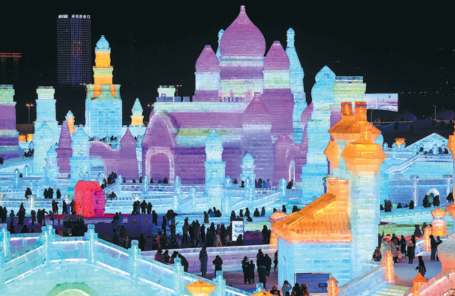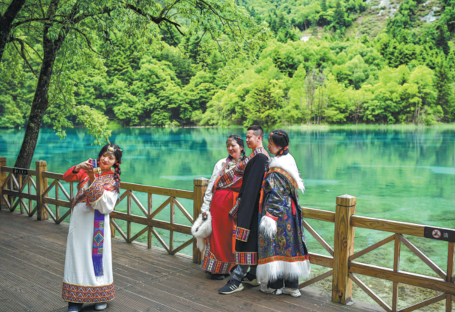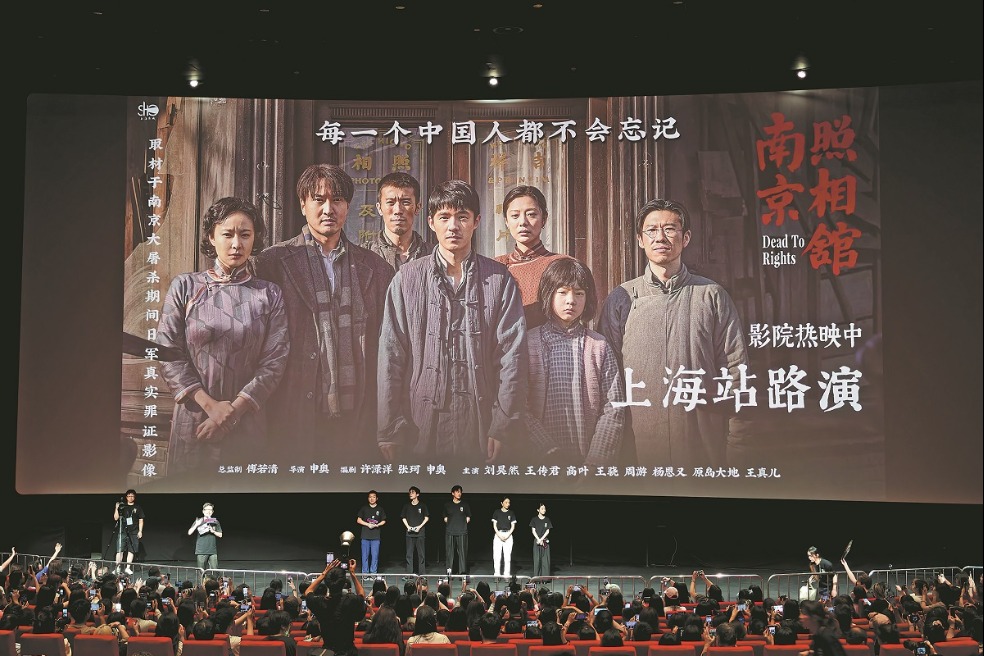Meeting plans route to boost tourism
Various incentives under discussion and importance of high quality stressed for sector, Yang Feiyue reports.

Government officials, experts and key participants in tourism met to discuss ways of stimulating domestic consumption in the sector in Ganzhou, Southeast China's Jiangxi province in early December.
Since the beginning of this year, the tourism industry has rapidly rebounded and shown robust recovery, said Du Jiang, vice-minister of culture and tourism, at the China Tourism Industry Development Annual Conference on Dec 8.
A recent report by the China Tourism Academy forecasts that domestic tourism visits will reach more than 5.4 billion, with the number roughly hitting 90 percent of that in 2019, before COVID-19 hit.
Tourism-related revenue this year is expected to reach 5.2 trillion yuan ($728 billion), about 91 percent of that of 2019, the report says.
"High-level recovery and high-quality development have become the most prominent labels of the tourism industry this year," Du says, adding that they stem from the resilience, potential and vitality of the economy, the continuous reform and innovation in the industry, and deep integration of culture and tourism.
Du urges related parties to further enrich the supply of high-quality tourism products, unlock the potential of tourism consumption, and fuel the vitality of the tourism market.
The goal is to better leverage the strong momentum of the tourism industry in stimulating consumption, supporting wider cultural understanding and contributing to the high-quality development of the economy.
Zhang Conglong, a senior expert from the cultural and communication industry research institute with China Telecom, says that efforts have been made to deliver new cultural tourism experiences.
For instance, the institute has built a dedicated 5G network in the Jiuzhaigou Nature Reserve of Sichuan province and realized the transmission of real-time video feeds.
"Using drones, we fly 12 kilometers into the scenic area, providing a live broadcast and adding a 30-minute night tour," Zhang says.
"Through this approach, we create an immersive experience for visitors."
At the same time, the institute has carried out several experiences integrating 5G with the metaverse that have received positive response from the market.
They range from a metaverse fireworks display during the 19th Asian Games in Hangzhou, Zhejiang province, and a re-creation of historical buildings in the ancient streets of Suzhou, Jiangsu province.
"We hope that the culture of Jiangnan (the southern region along the lower reaches of the Yangtze River) can endure in the world of the metaverse, or the digital realm," Zhang says.
Experts expect these approaches to stimulate interest in travel and encourage real-world tourism consumption.
On the big data front, telecommunications serve as a comprehensive data source that enables more convenient analysis of visitor flow patterns, thus providing better support for decision-making and improving tourism experiences, Zhang says.
He believes the time has come to use AI-generated content in the cultural and tourism industry, such as customized travel routes and services, tour guidance and digital marketing for destinations.
Jiang Yiyi, deputy dean of the sport, leisure and tourism school of Beijing Sport University, proposes more input into sports tourism, which has shown strong potential.
"Tourists often flock to a city for a sports event. Major international events such as the 2022 Beijing Winter Olympics, the Hangzhou Asian Games, and the Chengdu FISU World University Games have become iconic intellectual properties themselves," Jiang says.
To date, many cities have staged marathons and winter sports that have packed in visitors from home and abroad, she adds.
"Sports programs have certain technical thresholds, but once consumers master these skills, they are likely to engage in repetitive consumption," she says.
"Sports tourism can also be a strong force to drive sales of related consumer goods."
Jiang has noticed that many consumers may purchase skiing equipment and travel to ski resorts when winter comes.
She points out that more attention should be paid to how to transform sports venues into carriers for the integrated development of sports, culture and tourism after hosting major events, so as to continuously satisfy the needs of sports enthusiasts.
She calls upon various regions to establish a sports events hosting mechanism and differentiate sports programs to continuously attract tourists.
"Attention should be given to the diverse needs of nonprofessionals and consumer groups such as women and families with children," Jiang says.
Zhang Bo, deputy director of culture and tourism bureau of Yantai, East China's Shandong province, shares the city's experiences in increasing its high-quality tourism product supply and stimulating consumption potential.
Yantai was the first city in Shandong to propose advancing the marine cultural tourism industry chain, according to Zhang Bo.
In addition to launching policies to enhance incentives for greater consumption, distinctive culture and tourism scenes have been created to boost travel spending.
"Yantai has 1,000 km of coastline and hundreds of islands, and we have launched products by leveraging these advantageous resources," Zhang Bo says.
They include bird watching and night tours of the islands, he adds.
Sea tours integrating sightseeing, leisure, accommodation, catering and learning have also been developed.
From January to August, Yantai received 59.85 million traveler visits, generating tourism revenue exceeding 73 billion yuan, the official says.
The number of tourists increased by 44.9 percent compared to the same period last year, and tourism revenue saw a year-on-year growth of 53.7 percent.
"The growth in revenue significantly outpaced the increase in the number of visitors," Zhang Bo says.
"Currently, Yantai is leading the consumer market through themed festival activities, expanding consumption space through distinctive regional industries, and creating consumption hot spots through artistic and cultural experiences," he adds.
Those measures aim to make the local tourism consumer market more dynamic and attractive, he says.
Yin Long, CEO of Beijing Midi Music Media, has planned a nationwide music tour to help boost tourism.
The campaign has received support from the Ministry of Culture and Tourism, Yin says.
"It will be an original music competition staged across several cities and provinces," he says, adding that music tapping into local culture and customs will be encouraged.
Large-scale concerts and music festivals will also be staged after the competition, he says.
There are in excess of 300 music festivals hosting over 10,000 people across the country this year, and more than 900 large-scale concerts, according to Yin.
The strong public demand for related activities and government support are behind the booming music event market, which has given tourism a shot in the arm, he says.
He suggests staging regular music performances and festivals at scenic spots around the country to enhance travel experiences.
Zhang Hui, deputy director of the experts' committee of the Beijing-based World Tourism Cities Federation, highlights the role of investment in advancing sustainable tourism development.
"The opportunities for tourism investment lie in tapping into the potential of tourism consumption, meeting the requirements of high-quality tourism development … and addressing the shortcomings in China's tourism supply," he says, adding that it's also important to explore investment opportunities in urban planning.
He says that future investment will go to tourism products that are centered around health, learning, leisure streets, theme parks, art centers, villages and high-tech immersive experiences.




Today's Top News
- Japan must face up to its wartime past
- Vision turns county into green model
- China rolls out new visa type for young science talent
- Cambodia, Thailand urged to engage in dialogue, rebuild trust
- China stays at forefront of global digital growth
- Beautiful China vision has sown the seeds for the blossoming of an ecological civilization: China Daily editorial






























